As the seasons and the colours of the leaves are changing, autumn has finally come … White Autumn, to be precise. I am, of course, not referring to premature snowfall, but the colour of the Mercedes C111, the only colour this extremely rare car ever existed in, named after and in colour reminiscent of a type of German wine (Weißherbst) from the Mercedes factory region. But unlike the one-colour-only DeLorean, the C111 wasn´t a production car and unlike the Vision One-Eleven, no design study either. Quite down to earth, as Mercedes was back in the day, it was a testbed for alternative engine options like the Wankel rotary engines, which proved too unreliable due to wear to make it into production Mercs. And yet this picked up both on traditional Mercedes design elements like the 300 SL´s gullwing doors and latest fashions like pop-up headlights.


What Norev replicate here is the second generation of the C111, and you have to give them credit for having captured the shape and colour of the car really nicely. The edges at the A-pillars are remarkably sharp for a diecast metal car when we are being told that plastic can do this better (and would be more correct as the C111´s body was originally glass fibre). The air intakes behind the doors cannot be opened for real, but they are painted in the same matte black as the rear and front lids to create the illusion well enough. The three-pointed star front and rear are photoetched. The front corners´ indicators´ and taillights´ lenses are very well patterned and replicate mounting screws, with the sharply divided rears having light bulbs in each chamber, just like on the fog lights and the pop-up headlights that can be snappily operated by a switch underneath the front.
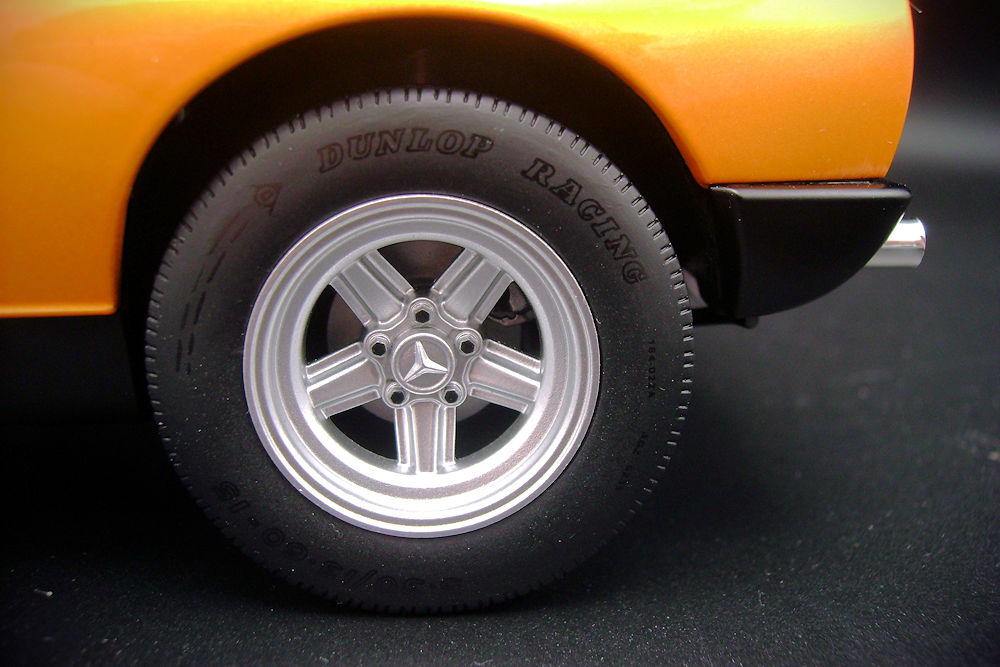
The wheels represent the rims well enough, unfortunately, without valves and with some rather simple brakes visible through the five spokes, but the tires are branded as the Dunlop Racing rubbers with which Mercedes put the car through its paces at Nürburgring, with Mercedes adamant they would not return to racing. Please note that the wheels are sprung on all four corners, which might account for the ride height being a little too high.
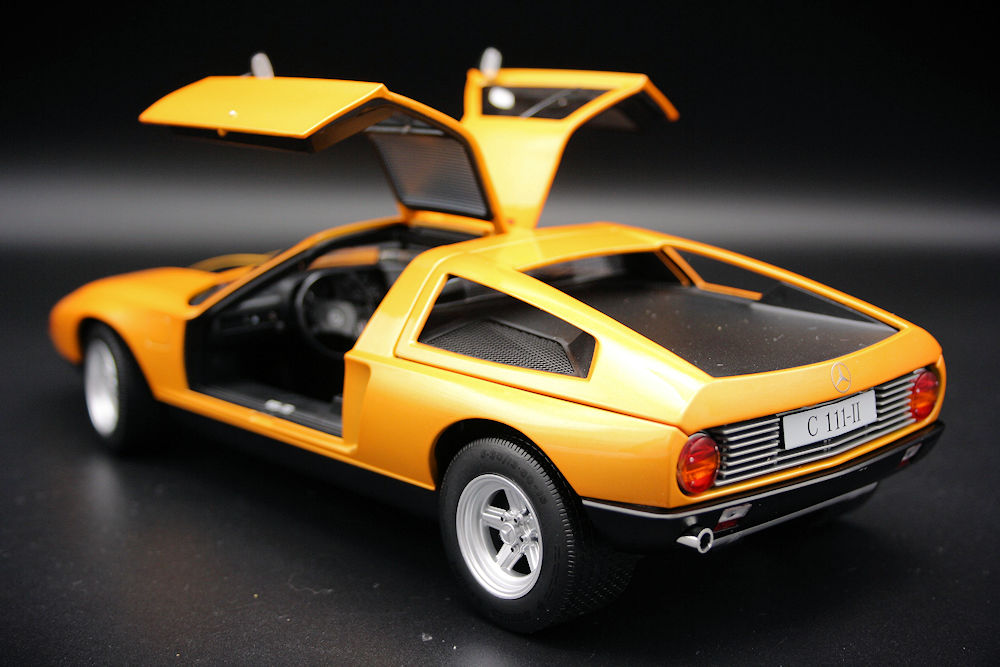
While the front´s lower section is not perforated, and the rear´s slats are convincing, but with a solid black plate behind it, both hoods have photoetched, perforated metal, allowing one to see the dual radiator fans in the front and the engine in the rear. Underneath the front hood that stays open without using the prop-rod, you find some tech and wiring underneath the mono-wiper and a boxed warning triangle next to the strapped-down unbranded spare tire.
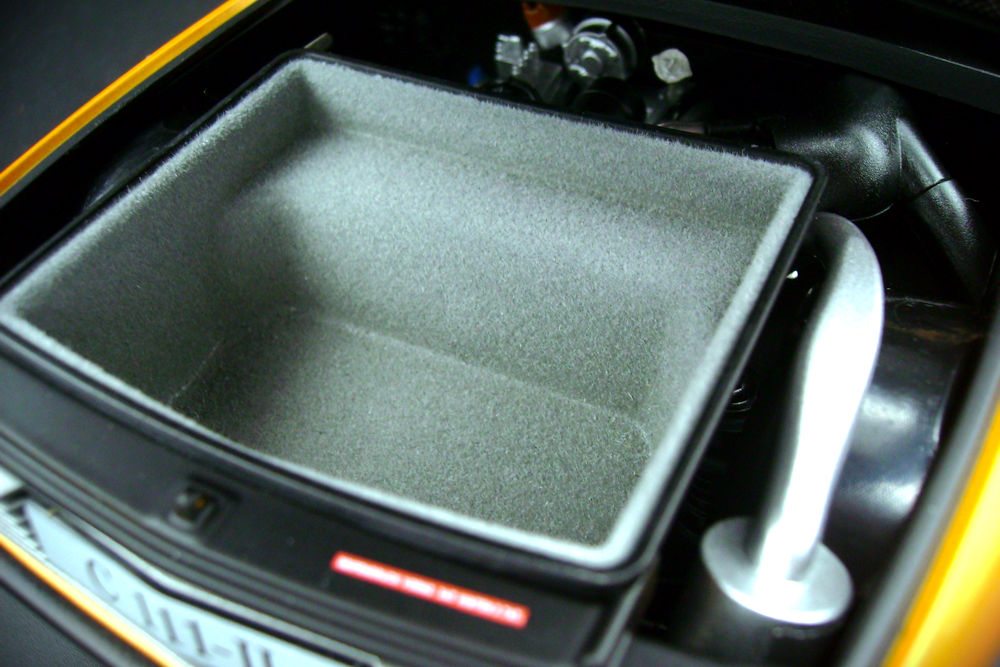
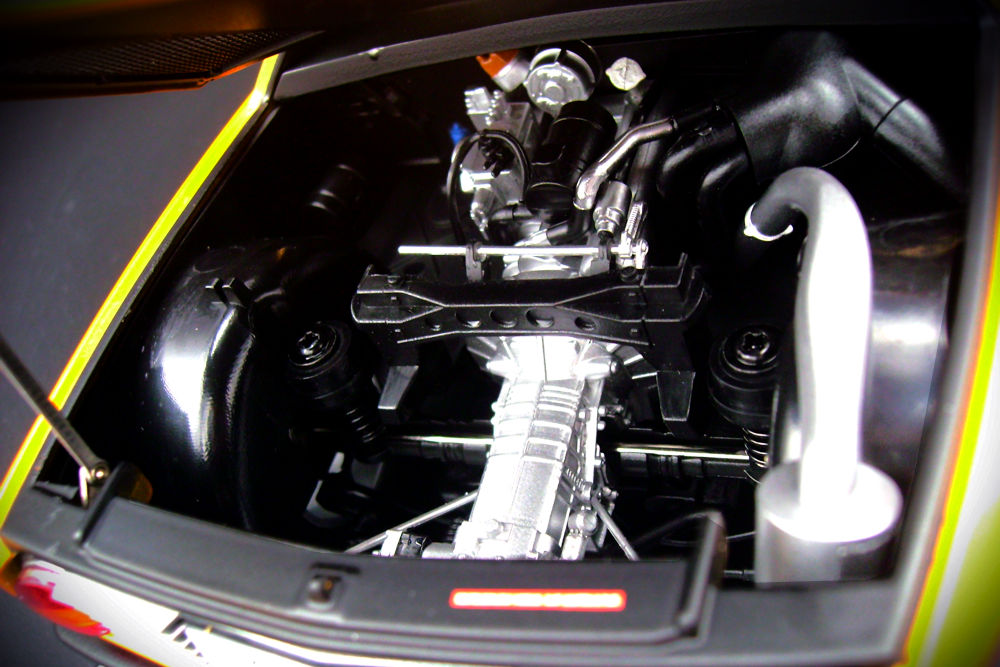
The rear is far more interesting. It does not open on the same collapsing opening rod, but this rod is present and functional in a non-collapsing version. Removing the carpeted boot-tub fully reveals the four-rotor version of the Wankel rotary engine tested in this car, including the bay being open at the bottom to admire the axle and transmission. Of course, it does not offer as much detail as an LCD Pagani´s, but aptly for this car, it is anything but a shallowly moulded tray, allowing the observer the recognize how compact it is. The removable tub was an afterthought by Mercedes, trying to create luggage space. Like the engine, this concept failed the practicality tests, with butter melting from the engine heat.


Accessing the fully carpeted interior through the gullwing doors, we hardly notice the absence of the gas-struts. We have seen on all 300 SL models how this is hard to replicate. Everything is so finely detailed, from the legible gauge cluster to the centre console with its AC, uprightly mounted radio and testing car´s electricity-kill-button to the air-vents, speakers, seat patterns and harness-locks that you are prepared to forgive Norev that the rubber seatbelts themselves appear unduly thick, while the doors have fabric loops in addition to delicate doors handles to help close them when seated. This was not a stripped track-only car, but tested for roadworthiness in Mercedes comfort.
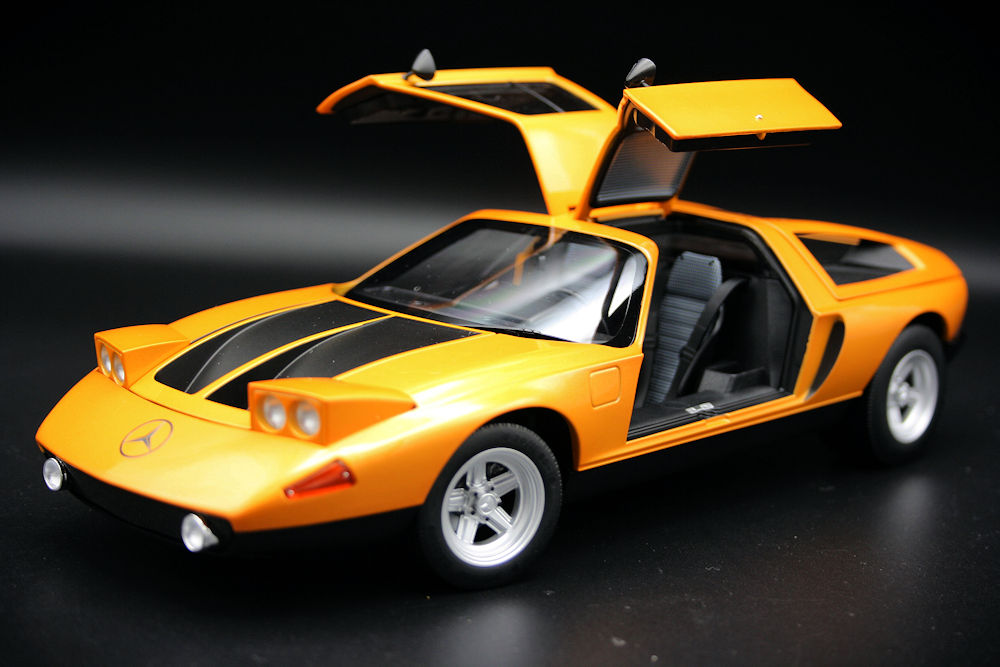
Although the C111´s tested engines ultimately failed to meet the raised bar of Mercedes standards and hence did not make it into their flagship production cars, this model of an iconic exotic is as much worth having as a piece of automotive history as Mercedes´orginial “tricycle”. It will easily be and remain the only model in your entire collection with a Wankel rotary engine and all these years (55 in fact!) later conveys 70s spirited poster star vibes. Otherwise, Mercedes would not have picked up on its design with its Vision One-Eleven.



















Thanks, Karsten, for the review and the bottle of German wine!
As for the model, this is another home run for Norev in 2025! I don’t care who you are and what themes you collect, Norev deserves praise for their continued support of quality models and uber value!
Personally, I believe this model excels over their exceptional Porsche 911 (964) Carrera 4 30 Jahre, recently reviewed, and the Carman 718. There are so many layers to this piece! Norev, thank you. Keep up the awesome work!
PS, I forgot to add, lovely photo capturing the essence of the season and colour of the exterior!
From what I see on the photos, Norev seems to be pretty close to Kyosho at their flourishing times!
Beautiful model. Is this still available?
Yes, absolutely! It was only released very recently.
Thanks for this nice review! It does the model very well justice. I have it here as well, and I love the way it is made, obviously with much affection for the subject. Some nice solutions for ample detailing without going crazy on the parts count and still giving it a premium feel.
In fact, the rear grille is perforated and see-through, the view to the engine bay is only blocked by the removable luggage tray! Must have done wonders for engine cooling on the real car, I imagine… Where the front grille is indeed not see-through, it is covered by a fine photoetch mesh grille on the model.
I agree on the stance, it is a bit high. I corrected it on my model, which is quite easily done by underlaying the suspension screws in the rear, which move into the engine bay when the suspension is compressed, and are visible when the luggage tray is removed. I did so with two layered bits of old plastic card. To lower the front it’s best to take the model apart, but this is also very easy. Here one layer is enough, and lowering it slightly makes a hell of a difference!
Great pictures!
I bet this model was paid for and ordered by Mercedes Benz AG.
This particular model was ordered and paid for by noone but myself.
He probably means model as whole. I hardly see Norev doing so much detailed model just for mercedes prototype, all by his own budget.
Actually, it is usually Mercedes standing on the brakes on detail for cost reasons.
I assume Tony was referring to what may have determined why Norev decided to make a model of such a rare car.
But perhaps you just have a great sense of humour Karsten :)
Actually I was wondering whether he might have meant that. Norev are known to by and by make all cars from Mercedes´ history to be sold by Mercedes dealers. So that seemed much too obvious.
The other irritating insinuation we often get here is that we get all these models as free samples, a favour to be returned by favorable reviews.
My answer was deliberately ambiguous, implying that the question wasn´t too precise. Call it sarcasm if you will.
That Norev are making all Mercedes models was not known to me, as such. That gives good hope that we’ll get a good and affordable 300 SLR Uhlenhaut Coupé at some point… The way they made this C111 is delightful and would be a perfect fit to the SLR.
Holy…!
I just got this model and this is by far the best work I’ve ever seen from Norev.
It’s even more detailed than the photos in this review let on.
And to think I didn’t even like the look of the original much…
Just received it. Couldn’t resist a first Alibaba xpress black friday sale. Disappointed. Actually good at validating overall accuracy. Been overwhelmed by the attention to details. Still the front lacked the presence of the real car. Felt less part from the rest of the body than on the real car. Like a nail or something too pointed. Couldn’t figure it out as the side profile seemed accurate. Indeed! The front is narrowing, following an already narrower (than it should) rear. Significanty. I’m not one of those who would complain on per say a CMC Bugatti Atlantic that is significantly accurate but that some say is too bulbous (go find any real flaw there). But this one just does not have the same stance and feel altogether. Too narrow, too pointy, bad proportions, awesome details!!! meh popups. One other thing that is obvious once you have the model in hand and that to me is a fatal flaw: the amplitude of opening parts (apart from the gullwing doors, which are absolutely perfect), cannot be reached without achieving permanent deformation. I’ll repeat, trunk and bonnet won’t open enough and if you want to reach the full amplitude dictate by their prop rods and flange, you’ll deform the hinge « permanently ». Not that it can be reversed but that it’s always a risky business to work/weaken a casting extensively.
“bonnet won’t open enough and if you want to reach the full amplitude dictate by their prop rods and flange,”
Thanks for the insight. I’ve experienced the same on the rear bonnet as well.
Yes the rear bonnet also. For the front bonnet, it changes the geometry and the permanent deformation will prevent you from closing it back properly. I passed the whole day thinking: nah! no big deal, it is narrower and so what. So what? Tonight I’m convinced I want to dismantle it fully and rebuild it around the Guiloy casting for which I will fill the panel gaps to perfection and thin the already good hinges it has. Norev has none of the presence that the Guiloy and/or BOS retain, but all the details it needs. For instance, the rear lights could not be done with more crisp finish and delicacy. As are those details of the instrument cluster and engine bay.
Also, too much candy in that orange. that orange should shine gold, not grapefruit color.
*pink grapefruit, that is.